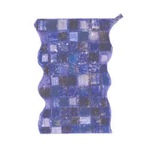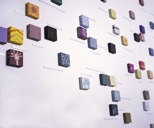> bio > a conversation with sally -
part 1 of 3
Would you like to tell us a bit of your personal history?
I grew up in a remote part of the USA, upper New York State near the Canadian border on a dairy farm with my parents, brother and sister. It was an idyllic childhood and I have nothing but good memories and I feel extremely lucky for this solid background.
Did you always want to be an artist?
Simply, yes. It was always my goal, but of course I did have interests in other subjects such as archaeology and literature.
Did you study to be an artist?
I studied art both as an undergraduate at The State University of New York at Albany and then did postgraduate studies at Hunter College in New York City.
Have you always worked as an artist?
Like most artists, I have had to do other things. When my son was little I needed to make enough money to live in a good New York City neighborhood and so I got a job on Wall Street. The financial world has a history of hiring artists. Artists are self-starters, hardworking and usually look at problems in unique ways.
How do ideas like Sacred Vessels and DAYS come about?
SACRED VESSELS started years ago when my son was little. I made up a story about rain and a fantasy world Arcus (Latin for rainbow). I had been toying with the idea of doing something with that story for a long time. When my mother died I felt a strong need for religion and then again after September 11 (I had worked in the World Trade Centre). I adore reading and re-reading the 1001 Arabian Nights and perhaps they played a part in influencing Sacred Vessels. I also have travelled extensively in Morocco; plus, I am very interested in the history of the Middle East. All these various thoughts played a part in Sacred Vessels as well as my love of archaeology and modern ceramics. One viewer of Sacred Vessels said she could see an interest in Pre-Columbian Art and I knew she was right.
DAYS came from an interest in recording the ups and downs that people experience over a year. Before DAYS, I did a project based on forty small boxes. The process of creating this piece made me consider how much a person changes from day to day. Even one's painting changes each day. Size was very important to me in this project. I consciously painted them on small wooden boxes. It is often easier for people to relate to something on a more intimate level.
How long does it take to complete a project?
There are so many aspects to executing a body of work. Developing the idea needs to have time for proper exploration and to give the artist time to decide on such things as the right size and material. These processes can go on over a period of days, weeks or even months. Once an idea has reached a certain point, you feel confident enough to show and discuss the idea with curators, venues, institutions, funding bodies etc. This is when the business side of art begins. This involves everything from discussions with the curator to photography, designs of promotional material, catalogues, applications, invitations, correspondence, location of venues, discussions with funding bodies and sponsorship etc. Some projects take years.
> a conversation with sally continued
Would you like to tell us a bit of your personal history?
I grew up in a remote part of the USA, upper New York State near the Canadian border on a dairy farm with my parents, brother and sister. It was an idyllic childhood and I have nothing but good memories and I feel extremely lucky for this solid background.
Did you always want to be an artist?
Simply, yes. It was always my goal, but of course I did have interests in other subjects such as archaeology and literature.
Did you study to be an artist?
I studied art both as an undergraduate at The State University of New York at Albany and then did postgraduate studies at Hunter College in New York City.
Have you always worked as an artist?
Like most artists, I have had to do other things. When my son was little I needed to make enough money to live in a good New York City neighborhood and so I got a job on Wall Street. The financial world has a history of hiring artists. Artists are self-starters, hardworking and usually look at problems in unique ways.
How do ideas like Sacred Vessels and DAYS come about?
SACRED VESSELS started years ago when my son was little. I made up a story about rain and a fantasy world Arcus (Latin for rainbow). I had been toying with the idea of doing something with that story for a long time. When my mother died I felt a strong need for religion and then again after September 11 (I had worked in the World Trade Centre). I adore reading and re-reading the 1001 Arabian Nights and perhaps they played a part in influencing Sacred Vessels. I also have travelled extensively in Morocco; plus, I am very interested in the history of the Middle East. All these various thoughts played a part in Sacred Vessels as well as my love of archaeology and modern ceramics. One viewer of Sacred Vessels said she could see an interest in Pre-Columbian Art and I knew she was right.
DAYS came from an interest in recording the ups and downs that people experience over a year. Before DAYS, I did a project based on forty small boxes. The process of creating this piece made me consider how much a person changes from day to day. Even one's painting changes each day. Size was very important to me in this project. I consciously painted them on small wooden boxes. It is often easier for people to relate to something on a more intimate level.
How long does it take to complete a project?
There are so many aspects to executing a body of work. Developing the idea needs to have time for proper exploration and to give the artist time to decide on such things as the right size and material. These processes can go on over a period of days, weeks or even months. Once an idea has reached a certain point, you feel confident enough to show and discuss the idea with curators, venues, institutions, funding bodies etc. This is when the business side of art begins. This involves everything from discussions with the curator to photography, designs of promotional material, catalogues, applications, invitations, correspondence, location of venues, discussions with funding bodies and sponsorship etc. Some projects take years.
> a conversation with sally continued


